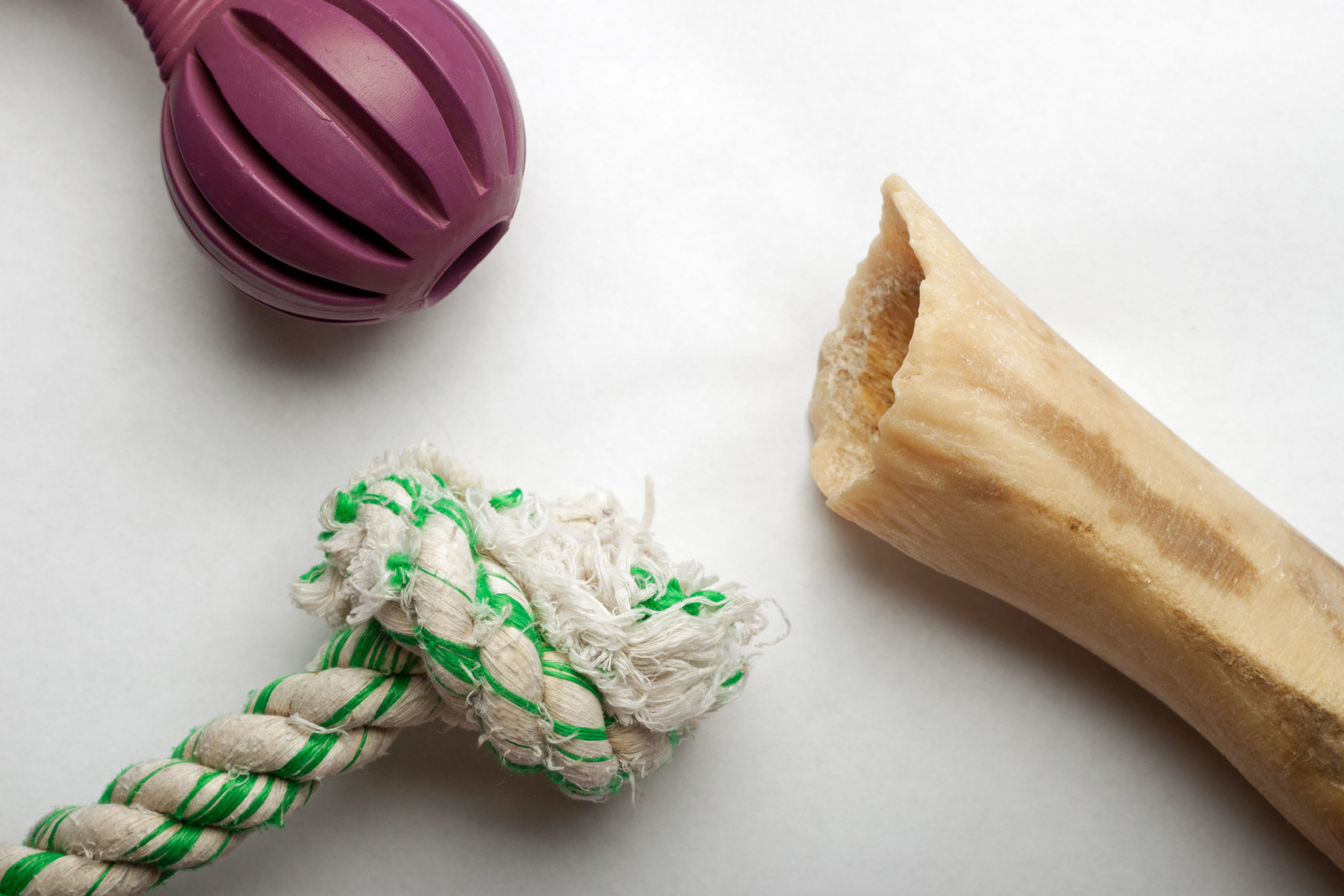The puppy stage can be quite adorable, leaving new dog owners smitten with their Bernedoodle pup. Unfortunately, teething is a natural stage that all puppies will go through as they begin to grow their new adult teeth. When can you expect your Bernedoodle to stop teething?
Most Bernedoodles will start to lose their puppy teeth between four and six months of age. By the time they are seven months old, most of their puppy teeth should be gone and adult teeth should begin to emerge. If your puppy passes this age and still has puppy teeth, you should address this with your veterinarian.
Most new dog owners are eager for this stage to pass. It can lead to problem behavior like chewing and biting. Understanding this essential phase of growth can help you to prevent major problems and give your pup more productive things to do.
Contents
When Do Bernedoodles Stop Teething?
Just like your human child, your Bernedoodle is going to have two sets of teeth. The first teeth often have several different names including:
- Deciduous teeth
- Primary teeth
- Baby teeth
- Milk teeth
- Puppy teeth
Their first set of teeth includes twenty-eight teeth while their more permanent adult set of teeth will contain forty-two. All dogs are born without any visible teeth in their mouth. Around three weeks of age, most Bernedoodle puppies will start to show their first signs of teething with these puppy teeth erupting through the gums. By six weeks, all of the primary teeth should be fully erupted.
In humans, adult teeth do not start erupting for several years. Puppies, on the other hand, go through the teething process relatively quickly. Three to four months into their life, most puppies will start to lose their baby teeth. The incisors are often the first ones to go and to be replaced with their permanent counterparts.
Your puppy should have lost all of its deciduous teeth by the time it is six to seven months old.
At this stage, your puppy is already developing the buds for its permanent teeth within the jaw. These developing buds press against the baby teeth and cause them to resorb into the jaw. This allows the crown of the tooth to fall out. You may find these tiny puppy teeth on your floor when you walk barefoot or in your puppy’s bedding. Most of the time, your puppy will swallow them which is perfectly normal and okay.
How Will I Know If My Bernedoodle is Teething?
Because most puppies are bound to swallow their baby teeth, how will you know when they are teething? The good news is that there are a few telltale signs that your dog is going through this phase of his development. Unfortunately, they are not great side effects for you as a pet owner.
The first symptom of teething is relatively benign. Your puppy may begin to drool more frequently or regularly as their adult teeth are coming in. If this is your only indicator that your puppy is teething, then you are quite lucky!
Another sign that they may be experiencing some discomfort is if they decline to eat. They may still eat their meals, but they could take it slower than usual. If your dog typically inhales his food, a slower pace could be a sign that he is experiencing some pain in his gums.
They may even be more irritable with you as a result of their discomfort. A happy-go-lucky dog may seem a bit off kilter when those adult teeth are coming through the gums.
However, most people recognize that their puppy is teething based on the amount of chewing that they are doing. Most dogs who are teething will want to chew on hard objects for a long period of time.
They will chew just about anything that you set in front of them, so it is essential that you give them something appropriate to chew on. Never allow them to chew on things that you will deem unacceptable later on such as shoes, clothing, towels, or furniture items. It can be confusing to your puppy if they are allowed to chew on something now but are forbidden from doing so in the future.
What If My Dog Doesn’t Lose His Puppy Teeth?
Every puppy has their deciduous teeth, but some dogs have a hard time losing these primary teeth. If you see a permanent adult tooth growing in the same spot as a baby tooth, it might be time to have it evaluated by a veterinarian. At this point, it is known as a persistent tooth and it can cause major problems.
If the baby tooth does not come out, it is taking the place where the adult tooth should be. This forces the permanent adult tooth to come in somewhere abnormal. This can lead to crowding issues as well as an irregular bite. Other issues include:
- Trapped food and debris between teeth
- Accumulation of food debris and plaque
- Tartar deposits
- Gingivitis
- Periodontitis
- Pain or infection
Persistent puppy teeth are most commonly found in the upper canines and lower canines followed by the incisors. However, any deciduous teeth can indeed become persistent teeth that refuse to move out of the way for permanent teeth.
Notify your veterinarian right away if you suspect that your Bernedoodle might have a persistent tooth. It will likely require extraction so that the adult tooth can move into its proper location in the mouth. If it is taken care of quickly, the adult tooth can still come in as usual, and many of the secondary problems can be resolved.
Many new dog owners prefer to wait for the extraction until they decide to spay or neuter their pet. While this does prevent your puppy from going under anesthesia twice, waiting can create some serious problems for your dog’s bite. It is best to get this taken care of as quickly as possible.
How to Reduce Destructive Chewing
The truth is that your puppy is going to lose its baby teeth eventually. The best thing you can do as a dutiful owner is to prepare for this stage adequately. Understand that your new Bernedoodle is going to want something to chew on with those razor-sharp baby teeth. There are a few tips and tricks you can use to reduce the amount of destructive chewing that your dog engages in.
Once you have accepted that this is just a normal stage of development, you can move on to more practical solutions. Finding appropriate things for your dog to chew on is of the utmost importance. This doesn’t even have to require a trip to the pet store. You might have appropriate things that can help around your house already.
Frozen treats are a great way to let your new puppy wear out those jaws. You can give them ice cubes straight from the freezer or frozen treats like carrots. Keep in mind that ice cubes can cause damage to the teeth, so these should be given sparingly. It is better to use some of the other types of toys available.
If you have a Kong ball, you can pack it full of goodies and then pop it in the freezer for later. Toys like this are great to give your dog when you need them to have some independent time. They can be great to leave with your dog when they are home alone so that they have fewer temptations to chew up your furniture, shoes, and other personal items.
Keep in mind that you want to give them treats that are going to stand up to their puppy teeth. Look for heavy duty items like those made by Kong. Alternatively, you can also look for heavy duty chews instead of the cheaper rawhides. It is best to find toys that aren’t going to be easily shredded, making a mess or allowing your Bernedoodle to ingest the parts.
Remember that feeding your dog bones is never a good idea. Even if they are cooked, it can lead to other major health issues. Chewing on bones can damage the teeth, but it can also be bad for their health. If they ingest the broken pieces (as many puppies will do), bone shards can also cause intestinal damage.
Related Questions
When do Bernedoodles stop biting?
Biting is a common behavior seen among puppies, particularly those who are teething. Most biting behavior calms down around the one-year mark for puppies. This is the time where your dog may start to settle down some and stop playing so roughly.
At what age do Bernedoodles stop growing?
Most dogs will lose their puppy teeth around the seven-month mark, but they are not done growing just yet. You can anticipate that your Bernedoodle will continue to grow until they are about one to two years old. They often reach their full height within a year, but it can take an additional year for them to fill out to reach their ideal adult weight.

